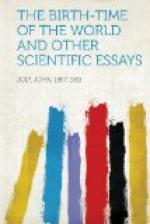299
necessarily finds, as the result of his contemplation, the aggregation of matter, and the consequences arising therefrom.
The negation of so primary a material property as gravitation to these primitive motions of (or in) the ether, probably involves the negation of many properties we find associated with matter. Possibly the quality of inertia, equally primary, is involved with that of gravitation, and we may suppose that these two properties so intimately associated in determining the motions of bodies in space were conferred upon the primitive motions as crystallographic attraction and rigidity are first conferred upon the solid growing from the supersaturated liquid. But in some degree less speculative is the supposition that the new order of motions involved the transformation of much energy into the form of heat vibrations; so that the newly generated matter, like the newly formed crystal, began its existence in a medium richly fed with thermal radiant energy. We may consider that the thermal conditions were such as would account for a primitive dissociation of the elements. And, again, we recall how the physicist finds his estimate of the energy involved in mere gravitational aggregation inadequate to afford explanation of past solar heat. It is supposable, on such a hypothesis as we have been dwelling on, that the entire subsequent gravitational condensation and conversion of material potential energy, dating from the first formation of matter to the stage of star formation
300
may be insignificant in amount compared with the conversion of etherial energy attending the crystallizing out of matter from the primitive motions. And thus possibly the conditions then obtaining involved a progressively increasing complexity of material structure the genesis of the elements, from an infra-hydrogen possessing the simplest material configuration, resulting ultimately in such self-luminous nebula as we yet see in the heavens.
The late James Croll, in his Stellar Evolution, finds objections to an eternal evolution, one of which is similar to the “metaphysical” objection urged in this paper. His way out of the difficulty is in the speculation that our stellar system originated by the collision of two masses endowed with relative motion, eternal in past duration, their meeting ushering in the dawn of evolution. However, the state of aggregation here assumed, from the known laws of matter and from analogy, calls for explanation as probably the result of prior diffusion, when, of course, the difficulty is only put back, not set at rest. Nor do I think the primitive collision in harmony with the number of relatively stationary nebula visible in space.
The metaphysical objection is, I find, also urged by George Salmon, late Provost of Trinity College, in favour of the creation of the universe.—(Sermons on Agnosticism.)
A. Winchell, in World Life, says: “We have not




